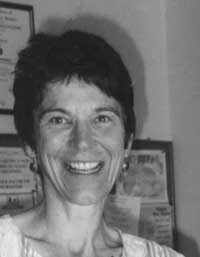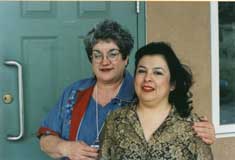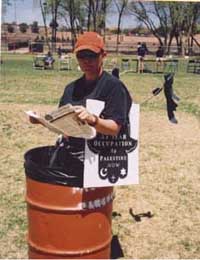 |
|
|
Volume VII |
May 2002 |
Number V |
|
|
Health Centers Celebrates 30 Years of Service By Betsy MartinezANNOUNCEMENTSEditorial: The National Fire Plan By Mark Schiller |
Proposed Valles Caldera Grazing Program By Kay Matthews Rio Arriba County Commission Candidates Attend Forum in Dixon |
Health Centers Celebrates 30 Years of ServiceOn April 25, the Peñasco clinic of Health Centers of Northern New Mexico (HCNNM) celebrated the 30th anniversary of the organization and clinic. Mardoqueo Chacon of Rodarte, the first executive director, told the crowd of clinic users and community friends the story of the organization. The clinic system began to serve the needs of rural and low income Northern New Mexicans in communities without a physician. Dr. Alfredo Vigil, CEO, updated the people on increasing difficulties of providing care due to reduced funding. New Mexico is one of the poorest state in the U.S., with 25.8% of the population without health insurance. A few problems facing the Peñasco area are: the difficulty for the elderly and those with limited transportation to access services in Taos or Española; the difficulty of staying at home rather than going to a nursing home when adult children cannot provide enough support for safe, at-home living; and the high cost of health care compared to income. 
Betsy Martinez, Physician's Assistant
Barbara Pacheco, office manager, and Debbie Romero, front office operations
Nursing staff Karen Castagna, Rachel Tafoya, Gabriella Tafoya, Sandra Gonzales
RaeLynn Abetya, medical records, operations
Juliette Garcia-Gonzales, board member
Dr. Alfredo Vigil, executive director Programs at the Peñasco HCNNM Clinic to ease the impact of high cost are: a contract with the Veterans Administration to provide primary care to local veterans, saving them the trip to Albuquerque; the Breast and Cervical Cancer program from the State of New Mexico, which provides free PAP smears with a well-woman physical and free mammograms for women 50 and over; free and confidential teen family planning and sexually transmitted disease care; free PAP smears and well-woman exams to low income, uninsured women over 19 years of age; a sliding fee scale for low to moderate income individuals for clinic services; an excellent diabetes care program; and Americorp workers to help with free medications from pharmaceutical companies. The gaps in care come for the "working poor" without health insurance when they need to see specialists or get tests and operations. The indigent fund at hospitals is limited and specific in its use, and the University of New Mexico Hospital in Albuquerque, unable to meet its expenses, severely reduced services for anyone not from Bernalillo County. Dental care is often impossible for low income people to access. The Peñasco HCNNM Dental Clinic is full to capacity and there is a two-year waiting list for new, non-emergency patients. In my opinion, not necessarily that of HCNNM, the health care crisis could best be solved by adopting a not-for-profit universal health care system similar to that of Canada and many European countries. New Mexicare has been proposed to the state legislature in recent years as a way to pool all of the state's resources (insurance premiums, Medicare, and Medicaid monies) and provide basic services to all. If we don't reduce the high percentage of overhead in healthcare wasted on insurance companies and layers of bureaucracy, it will be hard to provide the services people need. - Betsy Martinez, Physician's Assistant ANNOUNCEMENTSMay-June Events scheduled by the Quivira Coalition: • "Can Goats Save th West" with Lani Lamming, Taos, NM, Tuesday May 7, 9am-4pm at the Taos Country Agricultural Center, 202 Chamisa Road. Lamming, who has been working all over northern New Mexico with her goat herd, will demonstrate their effectiveness at getting rid of noxious weeds. La Jicarita will be there to see the goats at work. • Is "Long-Term Rest" the Answer to the Grazing Debate, a free workshop on Saturday, May 11th, 9am-4pm at the Sevilleta National Wildlife Refuge. • Hands-On Riparian Restoration Workshop with Bill Zeedyk on Largo Creek, Quemado, Saturday and Sunday, June 1-2. • Outdoor Classroom on Rangeland Health with Kirk Gadzia on the U-Bar Ranch, Silver City, Saturday and Sunday, June 22-23. • Valle Grande Grass Bank on Rowe Mesa Tour with Bill deBuys, Saturday, June 29. For more information call 505-820-2544 or visit the Quivira Coalition web site: www.quiviracoalition.org
• A new listener call-in show called Sustainable Solutions Radio Show will be airing on KTAO Solar Radio 101.9 in Taos on Wednesdays from 6:00 pm to 7:00 pm. The show is co-produced by KTAO radio and the California-based Sustainable Solutions and will address finding "earth-friendly" solutions to issues facing average citizens of Taos County. For more information log onto www.sustainablesolutions.org or call KTAO at 505 758-5826.
|
Proposed Valles Caldera Grazing ProgramBy Kay MatthewsJudging by the turn-out at the last board meeting on April 17 in Santa Fe, what the Valles Caldera Board of Trustees and staff intend to do about grazing on the Preserve is on everyone's radar screen these days. To a room full of ranchers, environmentalists, government agency people, and reporters, Gary Ziehe, executive director of the Caldera, and Dennis Trujillo, the manager, presented three proposed grazing alternatives that will be included in the Environmental Analysis (EA), due for release sometime in May . The three alternatives (by law there will be a no action alternative included as well) range from a minimum stocking of 800 head to a maximum of 2,000 in two to three of the three major valles: Valles Grande, Antonio, and Toledo. These numbers are based on favorable and unfavorabe conditions, and will be revised as more information is gathered. A month before, the Valles Caldera Coalition, a group founded in 1997 to advocate for federal purchase of the Baca Ranch, invited Craig Allen, a scientist with the U.S. Geological Survey's Biological Research division, to discuss the work he and other scientists are doing to design an "adaptive management plan" for the Preserve. Because the Preserve is managed by a Board of Trustees rather than a government agency like the Forest Service or Park Service (see La Jicarita, February 2002), these scientists see this as an opportunity to "institutionalize research" that is independent of management interference and allows for scientific "flexibility and creativity". At the Coalition meeting almost everyone agreed that institutionalized bureaucracy, the instability of staff moving up the GS ladder, and the constant demands of dealing with the public are the bain of agencies like the Forest Service, and that maybe the Trust can make decisions based on the best science available in an open process. But some folks at the meeting on April 17 and at previous public hearings, particularly those who desire to recreate in the Caldera, are already accusing the board of moving too fast to implement a grazing plan. The mandate of the Preserve, of course, is to work towards becoming self-sustaining, and a grazing program is an important component of that plan. Bill deBuys, board chair, pointed out that while there will probably be cattle on the Preserve sometime this summer, the board's decision regarding numbers and location will be based on best science management practices and that they will be using this interim grazing program to monitor grazing impacts. To gather data they will use ninety grassland transects, nine reparian transects, six paris of exclosures (one-half will exclude cattle and elk, one-half only cattle), and range riders to herd the cattle. But another obvious reason that the board and staff are preceeding with a grazing EA before a comprehensive recreation plan is that the necessary infrastructure to handle hikers, campers, fishermen, and skiers is simply not there. Access roads are only now starting to be worked on, a potable water system is being established at the Preserve headquarters, and a recreational fee plan is not even in the planning stages. At the April 17 meeting the staff did announce that a small-scale, interim recreation plan will be implemented this summer that will offer twice daily, four-day a week guided hikes of four to eight miles around the perimeter of the Preserve for a fee yet to be determined. The question of how the board will decide who will graze their cattle on the Preserve is a critical one and always comes up at public meetings. At both the Coalition meeting and the board meeting Allen and Ziehe stressed that the EA will include a social and economic analysis of the impacts of the grazing program. Forest Service EAs in northern New Mexico have typically been weak in these kinds of analyses, often offering cursory looks at only the impact on tourism or economic impacts rather than on cultural and traditional livelihoods and values. According to Dennis Trujillo, the Preserve staff will be working on criteria to determine a selection process that takes into account the social, cultural, and economic history and needs of northern New Mexico ranchers. They steer clear of using the word "permittee", however, preferring to use the word "contractor", which they see as inclusive of all ranchers who currently ranch on private, tribal, or public lands. Apparently the board and staff are not going to consider using the Preserve as a grassbank during. this interim grazing period, because, according to Ziehe, they couldn't collect the necessary fees or monitor the conditions of restoration work on home allotments. What we will probably see this summer is some late-season grazing that will help area ranchers deal with drought conditions. Abiquiu rancher and manager of rangelands at Ghost Ranch, Virgil Trujillo, also brought up the issue that the Preserve will have to incorporate elk managment in any grazing analysis it conducts. Elk hunts for 2002 have already been estabished - 85 lottery permits and five auction permit - but the board may have to increase these numbers dramatically. Hopefully, the data gathered in the next few years will provide that information. Rio Arriba County Commission Candidates Attend Forum in DixonRio Arriba County is at a critical juncture: Two positions on the commission that has led the county in its progressive land use planning - including ordinances protecting agricultural lands and regulating the development of gravel mining - are up for grabs. Four of the five candidates running for the commission showed up at a forum in Dixon on April 30: Elias Coriz from Chimayó; Charlie Trujillo from Chimayó; Sammy Medina from Córdova; and Joe Ciddio from Cañoncito. The issue of political patronage came up almost immediately. Several of the candidates are perceived as being allied with the former Naranjo machine that controlled county politics for many years, while several others are being supported by current county administrators who represent the "new Democrats". People see problems associated with both camps: The former machine that favored patronage over service and a current administration that has failed to adequately enforce some of the ordinances and regulations that are in place to protect the rural nature of the county. Joe Ciddio, who has a long history of county experience in alcohol and drug treatment, health care, economic development, and education but has never held political office, got a big laugh when he declared, "I don't have any family members who need employment." He went on to say that the reason he "threw my hat in the ring was to support the recent change in the flavor of politics in Rio Arriba County . . . which has to do with service to the community." One of the other candidates at the forum, Elias Coriz, is a current member of the Española school board and has had to defend his tenure on the board during a time of crisis in both educational accreditation and campus safety. Despite their affiliations with various factions of the community, all of the candidates stressed their independence and committed their support to a long list of issues: extending senior citizen services to all county villages; funding library services; supporting current planning and zoning efforts; pursuing return of the land grants; improving solid waste collection with transfer stations or better efficiency; collective bargaining; affordable housing; and fair distribution of county fire services. On the issue of waste water systems, Ciddio, Coriz, and Medina all agreed that small, low maintenance systems can be put in place in county communities rather than relying on the regional system that is currently being proposed. Trujillo suggested we begin using gray water for irrigation. Other than community forums, which oftentimes don't provide the opportunity for the audience or the candidates to address controversial issues in any depth, candidates must rely on newspaper ads, signs, and door-to-door campaigning. Ciddio has been running a series of ads in the Rio Grande Sun clarifying his position on most of the issues raised at the forum: affordable health care; continuing the process of the 30-year plan; strengthening drug treatment efforts; and correcting the imbalance in the distribution of county services. This is something all the candidates stressed at the forum: Regardless of the community they come from and the district they represent, they would try to represent all the citizens of the county in a fair and equitable way. It remains to be seen how the new commissioners will work with current county commissioner Moises Morales, whose tenure on the commission is associated with the change in power from the old machine to a more open process, and with the administrative staff that was brought on board to implement change. Lawsuit Filed on Behalf of Leonard PeltierRELEASE DATE: THURSDAY, APRIL 4, 2002 Contact: Leonard Peltier Defense Committee (785) 842-5774; lpdc@freepeltier.org NATIVE AMERICAN ACTIVIST FILES LAWSUIT AGAINST FBI Former FBI Director Louis Freeh is named as a defendant in a lawsuit filed today by attorneys for imprisoned Native American activist, Leonard Peltier. Freeh, along with the FBI Agents Association and a long list of active FBI agents, are accused of violating Peltier's Constitutional rights by making false and unsupported statements to the public, the Department of Justice, the United States Parole Commission, and former President Clinton. The complaint, filed in U.S. District Court, Washington D.C., alleges that the FBI "engaged in a systematic, and officially sanctioned campaign of mis-information and dis-information" designed to prevent Peltier from receiving fair clemency and parole reviews. The suit follows a highly controversial campaign conducted by the FBI to stop former president Bill Clinton from issuing Peltier a grant of executive clemency during his last days in office. FBI agents across the nation submitted letters to the editor, sponsored major newspaper and radio ads, and marched by the hundreds in front of the White House to discourage clemency. Former FBI Director Louis Freeh wrote searing letters to Bill Clinton and Janet Reno, to urge against Peltier's release. The campaign, which gained national attention, characterized Peltier as a cold-blooded killer who brutally shot two FBI agents at point blank range. Peltier's attorneys and supporters assert that this characterization is not only false but intentionally deceptive given the government's long- held position that it cannot prove who shot the agents Furthermore, they say it cost Peltier, now 57 years of age and in poor health, his long deserved freedom. Peltier has served more than 26 years in prison for the deaths of two FBI agents killed in a 1975 shoot-out on the Pine Ridge Indian Reservation. Peltier's supporters claim the FBI terrorized witnesses, utilized false testimony and withheld a ballistic test proving Peltier's innocence to gain his conviction. Senior Eighth Circuit Judge Gerald Heaney, who denied Peltier a new trial based on a legal technicality, has since come forward to support Peltier's release, citing FBI misconduct. Amnesty Internationa, the Kennedy Memorial Center for Human Rights, Rev. Jesse Jackson, Rigoberta Menchu Tum, Archbishop Desmond Tutu, Corretta Scott King, and scores of Native tribes are among those who consider Peltier a political prisoner who should be freed. (Complaint will be posted on LPDC web site on April 4: www.freepeltier.org Interviews with lawyer handling case and spokespeople for the LPDC can be arranged). Until Freedom Is Won! The New Peltier Justice Campaign Leonard Peltier Defense Committee PO Box 583 Lawrence, KS 66044 785-842-5774 www.freepeltier.org LettersLa Jicarita News: I read with interest your February interview with Antonio DeVargas. Mr. DeVargas expresses frustration that the federal government would not compensate him for losses relating to the Cerro Grande Fire. Mr. DeVargas did not receive compensation related to the Fire because he was not entitled to it. The summer of 2000, when the fire occurred, was one of the driest on record. The US Forest Service Regional Forester closed all the national forests in New Mexico to everyone but law enforcement, not because of the Cerro Grande fire, but because of drought. Cerro Grande was evidence of the drought but not the cause for closure of the forest. Mr. DeVargas was prevented from working in the forest by drought, not by the Cerro Grande fire. The 1977 La Mesa fire was started near Bandelier National Monument by a dirt motorbike lacking a spark arrestor. This source of forest fire is very common when any motors are used in dry woods and was the reason for the closure of the forest in summer 2000. In terms of the La Manga timber sale, I strongly question the ethics of people who would cut down some of the last nearly 1000 year old ponderosa pine in the Southwest, knowing it was highly unlikely they would be able to remove or process the logs. As a matter of respect for these elders, Mr. DeVargas could have left these huge trees standing until he was certain he could use them. But beyond that it was wrong for the Forest Service to offer them for cutting in the first place since rare large trees have a higher value standing than in any other form. I hope La Jicarita News will interview others who were involved in La Manga so readers may benefit from other perspectives. Tom Ribe PO Box 31151 Santa Fe, NM 87594 Editor's: La Jicarita News has previously interviewed several people from the environmental community regarding La Manga, including Joanie Berde and Sam Hitt. We asked Antonio DeVargas to respond to Ribe's letter. La Jicarita News: On March 20, 2002 Mr. Tom Ribe sent a letter to La Jicarita News and made comments related to a previous interview published in La Jicarita in February in which I expressed frustration that La Companía Ocho was denied compensation for losses that in my estimation were related to the Cerro Grande fire in the year 2000. As with many other enviromaniacs, there is a kernel of truth in a bushel of corn that is presented in a manner that deceives innocent and unknowing but concerned and well meaning people. For example, in the second paragraph of his letter he states a fact, that the summer of 2000 was one of the driest on record. He goes on to emphasize that Cerro Grande was evidence of drought but not the cause for the closure of the forests. That is the kernel of truth. The real sum of all this is that there have been many other droughts in which forest closures have not occurred, many before there even was a Forest Service and public lands were land grants. Today is April 15, tax day, almost a month since Mr. Ribe wrote his letter, and in that time 39,000 acres have burned in the Gila National Forest and 29 homes were lost in Ruidoso, along with 800 acres. The Gila, the Lincoln, the Cibola, and the Santa Fe national forests have imposed restrictions due to "extreme" fire and drought conditions. The Carson National Forest, where La Manga Timber Sale is located, has imposed no such restrictions, and had the Cerro Grande Fire not been ignited by the US government in 2000, there may not have been restrictions imposed because conditions here were not identical or even close to those in the Jemez Mountains during that time. The reality is that conditions are not identical in every region of the country or in New Mexico. One size does not fit all and the very expectation of it is the pinnacle of arrogance. I worked for Rio Arriba County Planning Department before and after the Cerro Grande Fire as the person responsible for monitoring timber harvesting in the county. The drought conditions did not in any way delay timber harvesting on any private forest in Rio Arriba County or in northern New Mexico. There was not one fire associated with timber harvesting operations anywhere in New Mexico in 2000, and for the readers of this paper, it is important that they know that when there is employment there are also assets in place to fight a fire that could threaten communities of humans and endangered species. Mr. Ribe has not shown concrete proof to me or anyone else that the trees we cut were anywhere near 1,000 years old, and I challenge him to go into La Manga with the media and me to prove this. The real truth is that Mr. Ribe, along with other fringe obstructionist groups, are intent on making sure that the Hispanic population of New Mexico makes no progress in its quest for justice on the land grant issue. They constantly harp on the idea that Hispanics should not log the forests because it is not the traditional kind of forestry in our communities. These same people forget that Native Americans did not traditionally get compensated for oil and gas leases, for golf courses and casinos, or timber harvests and big game hunts. They howl that we should have done forest restoration in La Manga at the same time they appeal restoration projects in the Santa Fe Watershed and other areas that desperately need work. The fact is that the prescription in La Manga was designed to both restore an overgrown forest and provide economic benefit to the community. I suspect that Mr. Ribe and others like him would like to see the Hispanic communities of northern New Mexico stay oppressed.
|
Home | Current Issue | Subscribe | About Us | Environmental Justice | Links | Archive | Index
Copyright 1996-2002 La Jicarita Box 6 El Valle Route, Chamisal, New Mexico 87521.








